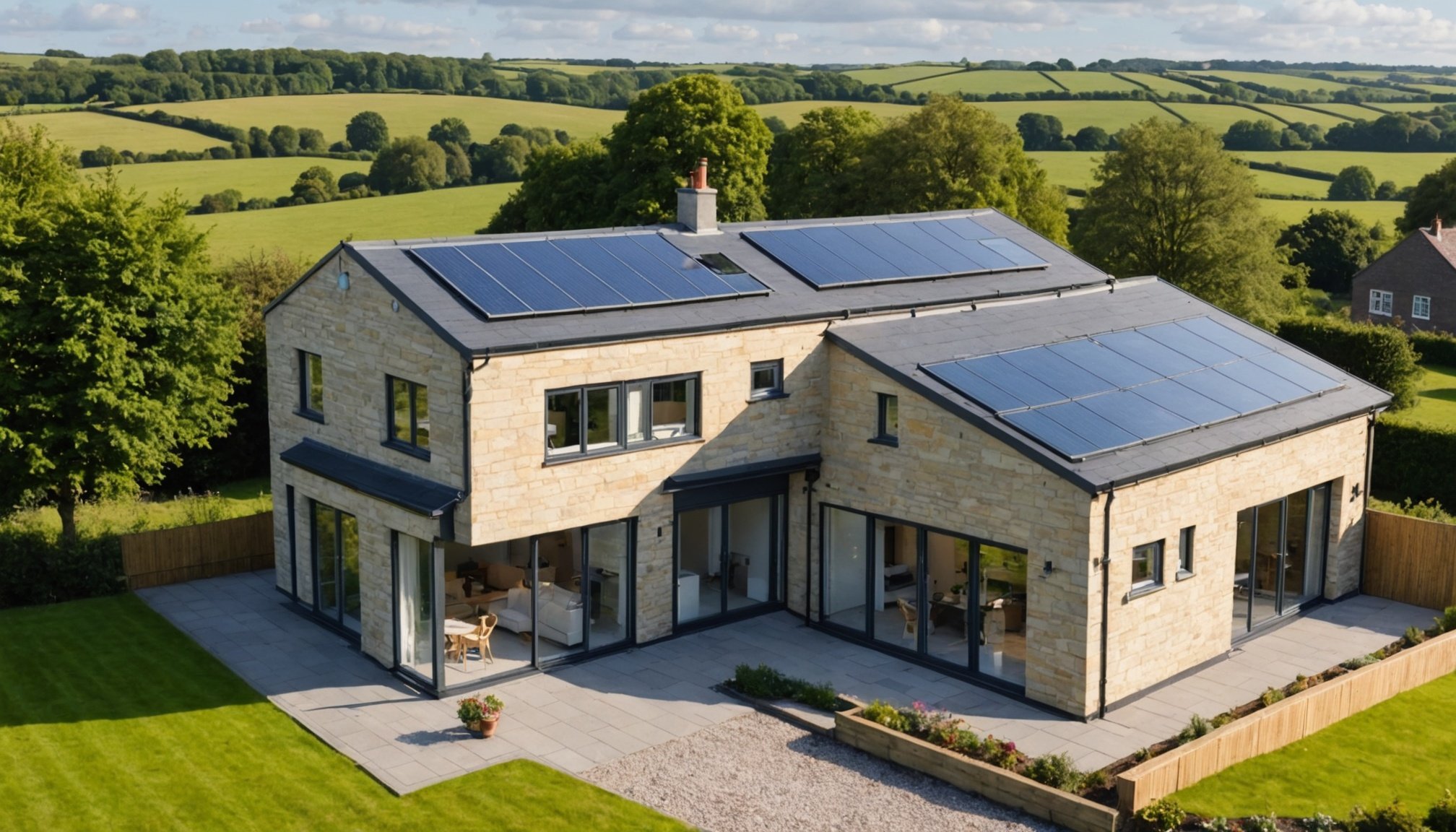Toward Carbon-Free Living: Navigating Challenges for Zero-Emission Homes in the North of the UK
As the world grapples with the pressing issue of climate change, the UK has set an ambitious goal to achieve net zero carbon emissions by 2050. A crucial component of this strategy is the transformation of the housing sector, particularly in the north of the UK, where harsher climates and older housing stocks present unique challenges. In this article, we will delve into the initiatives, challenges, and innovative solutions that are shaping the future of zero-emission homes in this region.
The Future Homes Standard: A New Era in Housing
The Future Homes Standard, announced in 2019, is a cornerstone of the UK’s plan to reduce carbon emissions from new homes by 2025. This standard aims to make all new homes “Net Zero Ready,” cutting carbon emissions by 75-80% compared to previous standards[1].
Key Aspects of the Future Homes Standard
- Energy Efficiency: New homes must feature advanced insulation, air-tightness, and low-carbon heating systems such as air source heat pumps. The phase-out of gas boilers, although still under consultation, is a significant aspect of this standard.
- Building Regulations Enhancements: The 2022 regulations saw a 31% uplift in energy efficiency requirements. There is also a critical emphasis on overheating mitigation, with builders required to incorporate natural ventilation, shading, and other cooling techniques into their designs[1].
- Documentation and Compliance: Comprehensive documentation, including photographic evidence at each stage of construction, is mandatory to ensure compliance with design specifications. Every dwelling must be individually assessed and air-tested, rather than just a sample[1].
Progress and Challenges
While significant progress has been made, the journey to 2025 is not without its challenges.
What’s Working
- Energy Efficiency Improvements: Many builders have adopted new technologies, improving the energy efficiency of new homes. The installation of heat pumps and solar panels has increased significantly, aligning with the standard’s goals[1].
- Overheating Mitigation: Compliance with new overheating regulations has been positive, with effective incorporation of cooling techniques into designs[1].
Challenges
- Gas Boiler Phase-Out: The proposed ban on gas boilers in new homes by 2025 has been delayed due to ongoing consultations, creating uncertainty in the industry[1].
- Documentation Burdens: Increased documentation requirements have added significant administrative burdens, particularly the need for detailed photographic records and geo-tagging[1].
- Stalled Initiatives: The decision to prevent new homes from connecting to the gas network is still under consultation, leading to delays in finalizing building plans that comply with this aspect of the standard[1].
Innovative Heating Solutions
The transition to zero-emission homes requires innovative and scalable heating solutions. Here are some of the cutting-edge approaches being explored:
Also to discover : Innovative Approaches to Integrating Public Art in Modern Development Projects
Heat Pumps and Beyond
- Electrical Heat Pumps: Already making significant inroads, heat pumps are a key component of the low-carbon heating strategy. However, their widespread adoption will require substantial increases in electricity generation and grid flexibility[4].
- Hybrid Boilers: Combining traditional gas boilers with hydrogen or other low-carbon fuels is another promising approach. For example, Dr. Bruno Cardenas from the University of Nottingham has introduced a heat-driven heat pump that uses hydrogen as fuel, offering higher efficiency and avoiding the strain on the electricity grid during peak times[4].
Repurposing Existing Infrastructure
- Non-Potable Water Distribution: Dr. Ramin Mehdipour from the University of Nottingham has proposed repurposing the existing gas network to distribute non-potable water, which can improve the performance of heat pumps during very cold days[4].
- Aqueous Ammonia: Dr. Zahra Baniamerian has explored the use of existing gas pipelines to distribute aqueous ammonia, which can be burned cleanly in a boiler to provide heating[4].
Addressing Climate Change and Energy Efficiency
The UK’s commitment to net zero is closely tied to addressing climate change and improving energy efficiency.
Climate Change Implications
- Rising Temperatures: The UK is facing increasing summertime temperatures due to climate change, which can lead to indoor overheating and health issues. Up to 20% of the English housing stock is already experiencing indoor overheating, which may be exacerbated by energy efficiency measures applied without sufficient cooling strategies[3].
- Vulnerable Groups: The impact of climate change on heating and cooling needs is particularly significant for older people, the fuel poor, and other climate-vulnerable groups. Ensuring these groups can adequately heat and cool their homes is crucial for health and well-being[3].
Energy Efficiency Measures
- Retrofitting Existing Homes: Given that existing domestic buildings will account for approximately 75% of the 2050 UK housing stock, retrofitting these structures is key. This includes installing loft insulation, cavity wall insulation, and solid wall insulation to meet energy efficiency targets[3].
- Economic Benefits: Improving building energy efficiency can result in significant economic benefits, including a potential £6.8 billion boost to the UK economy through direct economic impacts, social benefits, and job creation[3].
Role of Government and Local Authorities
The success of the transition to zero-emission homes heavily depends on the support and policies of both the government and local authorities.
Government Initiatives
- Clean Energy Superpower Mission: The UK government has outlined immediate steps to accelerate to net zero, including lifting the onshore wind ban, consenting large amounts of solar power, and kickstarting the carbon capture and hydrogen industries[5].
- Funding and Incentives: The government’s Warm Homes Plan and other initiatives provide funding and incentives for homeowners and builders to adopt low-carbon technologies. Stable, long-term policy support is crucial for driving long-term change[4].
Local Planning and Engagement
- Local Planning: Local authorities play a critical role in implementing local planning policies that support the transition to zero-emission homes. This includes ensuring that new developments comply with the Future Homes Standard and incorporating green spaces and sustainable design principles[2].
- Public Engagement: Active public participation is essential for the successful transition to clean heating solutions. Clear communication strategies and government support are vital in educating homeowners about the benefits and practicalities of low-carbon living[4].
Practical Insights and Actionable Advice
For those looking to embark on the journey to zero-emission living, here are some practical insights and actionable advice:
Choosing the Right Heating Solution
- Assess Your Needs: Before selecting a heating solution, assess your home’s specific needs, including its size, insulation, and current heating system.
- Consider Hybrid Solutions: Hybrid boilers that combine different fuels can offer flexibility and efficiency.
- Consult Professionals: Engage with builders and energy experts to ensure that your chosen solution is compliant with the Future Homes Standard and meets your energy efficiency goals[4].
Enhancing Energy Efficiency
- Insulation and Air-Tightness: Ensure your home is well-insulated and air-tight to maximize the efficiency of your heating system.
- Natural Ventilation: Incorporate natural ventilation techniques to mitigate overheating and improve indoor comfort.
- Solar Panels: Consider installing solar panels to generate clean energy and reduce your reliance on the grid[1].
The path to zero-emission homes in the north of the UK is complex but promising. As we navigate the challenges and opportunities presented by the Future Homes Standard, it is clear that a combination of innovative technologies, robust government policies, and active public engagement will be crucial.
Key Takeaways
- Diversity of Solutions: A one-size-fits-all approach is unlikely; diverse solutions tailored to different scenarios will be necessary[4].
- Scalability and Flexibility: Solutions must be scalable and flexible to meet the varied needs of different homes and regions[4].
- Long-Term Policy Support: Consistent policy backing is essential for driving long-term change and ensuring the UK meets its net zero targets[4].
As we move forward, it is imperative that we continue to innovate, collaborate, and adapt to the evolving landscape of low-carbon living. The future of our homes and our planet depends on it.
Detailed Bullet Point List: Key Challenges and Solutions
-
Challenges:
-
Gas Boiler Phase-Out: Delayed consultations on the ban of gas boilers in new homes.
-
Documentation Burdens: Increased administrative burdens due to detailed documentation requirements.
-
Stalled Initiatives: Delays in finalizing building plans due to ongoing consultations on gas network connections.
-
Climate Change Implications: Rising temperatures and indoor overheating issues.
-
Vulnerable Groups: Ensuring adequate heating and cooling for older people, the fuel poor, and other climate-vulnerable groups.
-
Solutions:
-
Innovative Heating Solutions: Heat pumps, hybrid boilers, repurposing existing infrastructure for non-potable water distribution and aqueous ammonia.
-
Energy Efficiency Measures: Retrofitting existing homes with insulation, natural ventilation, and solar panels.
-
Government Initiatives: Clean Energy Superpower Mission, funding and incentives for low-carbon technologies.
-
Local Planning and Engagement: Implementing local planning policies, public engagement, and clear communication strategies.
-
Practical Insights: Assessing home needs, consulting professionals, enhancing insulation and air-tightness, and incorporating natural ventilation.
Comprehensive Table: Future Homes Standard Requirements
| Aspect | Requirement | Impact |
|---|---|---|
| Energy Efficiency | Advanced insulation, air-tightness, low-carbon heating systems | 75-80% reduction in carbon emissions[1] |
| Building Regulations | 31% uplift in energy efficiency requirements, overheating mitigation | Improved energy efficiency, reduced overheating[1] |
| Documentation and Compliance | Comprehensive documentation, individual assessment and air-testing | Ensures compliance with design specifications[1] |
| Heating Systems | Phase-out of gas boilers (under consultation), use of heat pumps and hybrid solutions | Reduced carbon emissions from heating[1][4] |
| Retrofitting | Installation of loft insulation, cavity wall insulation, solid wall insulation | Improved energy efficiency in existing homes[3] |
| Local Planning | Compliance with local planning policies, incorporation of green spaces and sustainable design | Supports transition to zero-emission homes[2] |
By understanding these requirements and challenges, we can better navigate the transition to zero-emission homes, ensuring a sustainable and carbon-free future for generations to come.






